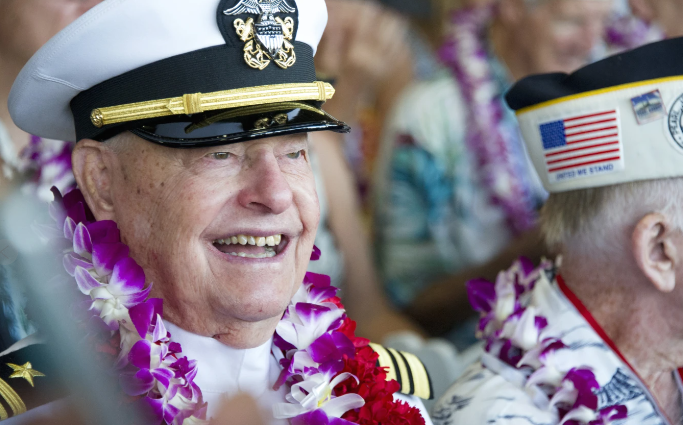HONOLULU (AP) — The last living survivor of the USS Arizona battleship that exploded and sank during the Japanese bombing of Pearl Harbor has died. Lou Conter was 102.
Conter passed away at his home Monday in Grass Valley, California following congestive heart failure, his daughter, Louann Daley said.
The Arizona lost 1,177 sailors and Marines in the 1941 attack that launched the United States into World War II. The battleship’s dead account for nearly half of those killed in the surprise attack.
Conter was a quartermaster, standing on the main deck of the Arizona as Japanese planes flew overhead at 7:55 a.m. on Dec. 7 that year. Sailors were just beginning to hoist colors or raise the flag when the assault began.
Conter recalled how one bomb penetrated steel decks 13 minutes into the battle and set off more than 1 million pounds of gunpowder stored below
“Guys were running out of the fire and trying to jump over the sides,” Conter said. “Oil all over the sea was burning.”
His autobiography “The Lou Conter Story” recounts how he joined other survivors in tending to the injured, many of them blinded and badly burned. The sailors only abandoned ship when their senior surviving officer was sure they had rescued all those still alive.
The rusting wreckage of the Arizona still lies in waters where it sank. More than 900 sailors and Marines remain entombed inside.
Conter went to flight school after Pearl Harbor, earning his wings to fly PBY patrol bombers, which the Navy used to look for submarines and bomb enemy targets. He flew 200 combat missions in the Pacific with a “Black Cats” squadron, which conducted dive bombing at night in planes painted black.
In 1943, he and his crew where shot down in waters near New Guinea and had to avoid a dozen sharks. A sailor expressed doubt they would survive, to which Conter replied, “baloney.”
“Don’t ever panic in any situation. Survive is the first thing you tell them. Don’t panic or you’re dead,” he said. They were quiet and treaded water until another plane came hours later and dropped them a lifeboat.
In the late 1950s, he was made the Navy’s first SERE officer — an acronym for survival, evasion, resistance and escape. He spent the next decade training Navy pilots and crew on how to survive if they’re shot down in the jungle and captured as a prisoner of war. Some of his pupils used his lessons as POWs in Vietnam.
Conter retired in 1967 after 28 years in the Navy.
Conter was born in Ojibwa, Wisconsin, on Sept. 13, 1921. His family later moved to Colorado where he walked five miles (eight kilometers) one way to school outside Denver. His house didn’t have running water so he tried out for the football team — less for a love of the sport and more because the players could take showers at school after practice.
He enlisted in the Navy after he turned 18, getting $17 a month and a hammock for his bunk at boot camp.
In his later years, Conter became a fixture at annual remembrance ceremonies in Pearl Harbor that the Navy and the National Park Service jointly hosted on the anniversaries of the 1941 attack. When he lacked the strength to attend in person, he recorded video messages for those who gathered and watched remotely from his home in California.
In 2019, when he was 98, he said he liked going to remember those who lost their lives.
“It’s always good to come back and pay respect to them and give them the top honors that they deserve,” he said.
Though many treated the shrinking group of Pearl Harbor survivors as heroes, Conter refused the label.
“The 2,403 men that died are the heroes. And we’ve got to honor them ahead of everybody else. And I’ve said that every time, and I think it should be stressed,” Conter told The Associated Press in a 2022 interview at his California home.





